
10 Dazzling Denizens of the Depths
Throughout recorded history, few things have fascinated mankind more than the oceans and seas of our wonderful world. Part of that fascination was, of course, their movements and unpredictability. But perhaps even more, the unfathomable array of life with which the waters teemed drew our collective attention. As examples of the life with which we have long been fascinated, we present to you a list of 10 Dazzling Denizens of the Depths. That fascination has inspired us, captivated us, and at times terrified us.
The almost unimaginable array of life beneath the waves astounds us to this day. Despite our many centuries of sailing the waters of the world, Nature continues to astound us. We discover new species at almost every turn. Our knowledge of species, both new and long recognized, grows at an astonishing rate. Yet it still does not suffice to keep up with what Nature reveals to us. The forms of life presented herein represent a random selection for your reading pleasure and edification. We hope you enjoy learning more about them as much as we do.
Sunflower Sea Star
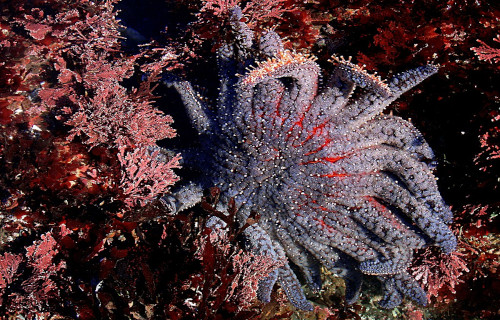
CCL: https://bit.ly/3uuR9Zj
Sunflower Sea Star Facts
- Leading off this article about 10 Dazzling Denizens of the Depths comes the fascinating creature named the Sunflower Sea Star.
- This stunning marine creature most frequently goes by the descriptive, as well as informative, common name for understandable reasons. That term’s easier to pronounce than its official name, thankfully. The technical name’s truly hard to pronounce.
- That’s because scientists know it best by the term of the Pycnopodia helianthoides. Regardless of which name one uses to refer to it though, it’s a marvel of evolution. It also stands out from its many related species due to the sheer size mature adults attain.
- The German-Russian naturalist Johann Friedrich von Brandt made the first formal recognition of it as a separae and distinct species. This noteworthy acknowledgement he accomplished in the year 1835. The reason for the name is a matter of speculation.
- Unfortunately, the population of this marvelous creature began to decline precipitiously around the year 2013. At that time, researchers discovered that much of its population suffered from a disease appropriately called Sea Star Wasting Disease.
- Evidence further indicates that the population loss for the species since that time approaches 90%. The IUCN, therefore, presently lists it as Critically Endangered. Sadly, though, the Sunflower Sea Star also remains vulnerable to the effects of climate change.
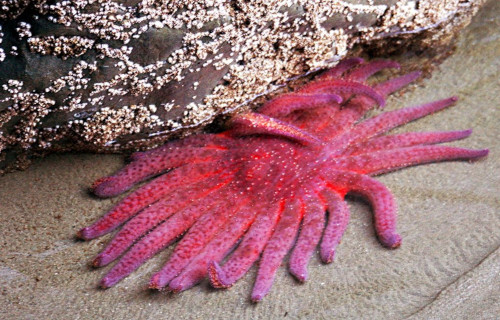
CCL: https://bit.ly/3fzndXL
Sunflower Sea Star Physical Description
Many animals garner admiration or appreciation either for their size or appearance, but not the Sunflower Sea Star. That’s because it easily qualifies as one of the very small percentage that deserve notice for both qualities. The animal shows no sexual dimorphism, though.
For the moment, its ranking in terms of size remains a matter of small debate among researchers. As it currently stands, therefore, it’s either the largest or the second-largest of all known sea stars. Either ranking clearly earns it a full measure of notice.
Mature individuals of this amazing species attain an arm span of as much as 3.3 ft ( 1m)! Another species, though, the Midgardia xandaros, actually possesses a significantly greater arm span. It has a much smaller body and mass than the Sunflower Sea Star, however.
The appearance of this wonder of Nature also earns it much notice among those who encounter it. That’s because most adults display between 16 – 24 arms. Interestingly, however, infants have only 5 of these. The others appear as the creature ages.
The enormous echinoderm further tends to present bright, vivid colors. These also vary broadly between individuals, apparently independent of gender. These hues include shades of red, pink, orange, yellow, and brown. Some individuals even present shades of purple.
- Kingdom: Animalia
- Phylum: Echinodermata
- Class: Asteroidea
- Order: Forcipulatida
- Family: Asteriidae
- Genus: Pycnopodia
- Species: P. helianthoides
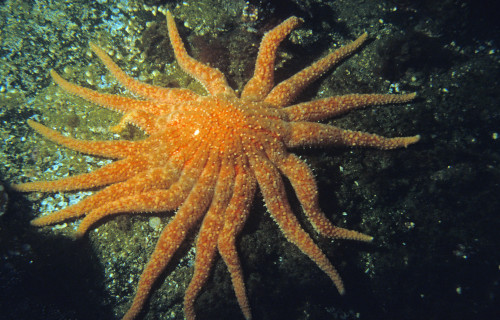
CCL: https://bit.ly/3vwggfI
Sunflower Sea Star Distribution, Habitat, and Ecology
Although the population of the magnificent Sunflower Sea Star has greatly diminsihed, its overall range remains the same. It also evolved as endemic to a relatively wide swathe of the Pacific Ocean. More precisely, it appears in parts of the northeast Pacific Ocean.
Within that region of the globe, the animal appears, though now in small, scattered concentrations, in a specific territory. That native range extends from southern California, in the continental United States, in North America, to as far north as the state of Alaska.
The creature further displays very definite preferences in its choice of habitat. Virtually all observed individuals appear in either subtidal or intertidal regions. Its depth range typically extends from 435 – 1,428 ft (132.6 – 435.3 m). It also appears in regions of kelp or seaweed.
It’s also relatively quick, for a member of its Order. With its roughly 15,000 tube feet, it moves along the sea floor at speeds of roughly 3.3 ft (1 m) per minute. The carnivore prefers to dine mainly on sea urchins, but also consumes snails, sea cucumbers, and clams.
Its own predators include large fish, and even other sea stars of sufficient size, while it’s still young. The king crab also considers it a favorite meal. The animal even has the ability to break off one or more of its own arms, if attacked. This lets it escape complete consumption.
The remarkable Sunflower Sea Star, like others of its kind, reproduces through broadcast spawning. The young begin life as microscopic larvae, that float to the surface for 2 – 10 weeks. Following this period, they drop to the ocean floor, to live out the rest of their lives.
Great White Shark
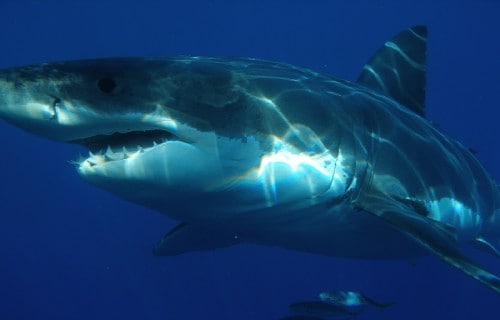
Great White Shark Facts
- The Great White Shark represents a species of large shark inhabiting nearly all oceans. It also remains one of the oceans primary apex predators.
- This incredibly efficient hunter has no known predators of its own, except for rare attacks by orcas when other, easier prey cannot be found.
- It exemplifies a fast and far-ranging hunter. It can reach speeds of as much as 35 mph (56 kph) and depths of as much as 3,900 ft (1,200 m).
- The IUCN currently lists this terrifying, but nonetheless majestic creature as Vulnerable.
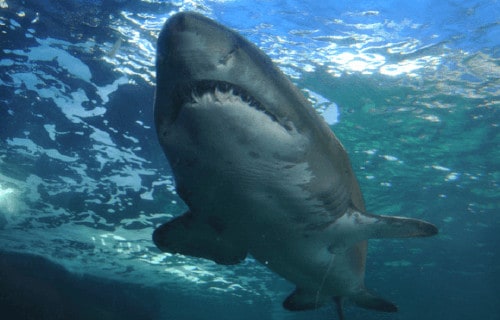
Great White Shark Physical Characteristics
The impressive Great White Shark attains a maximum known length of 20 ft (6 m) and weighs as much as roughly 5,000 pounds (2,268 kg). Reports of larger individuals occur but remain undocumented.
Most commonly it appears grayish in color on the top part of its body and white underneath. Like many species of sharks, the Great White has multiple rows of teeth.
Like all sharks, it also possesses a special sensory organ which allows them to detect the electromagnetic fields generated by the movement of living animals.
In this species, this sense seems to be especially acute, allowing it to detect a field of half a billionth volt. This represents less than that generated by the beating of a human heart.
Kingdom: Animalia
Phylum: Chordata
Class: Chondrichthyes
Order: Lamniformes
Family: Lamnidae
Genus: Carcharodon
Species: C. carcharias
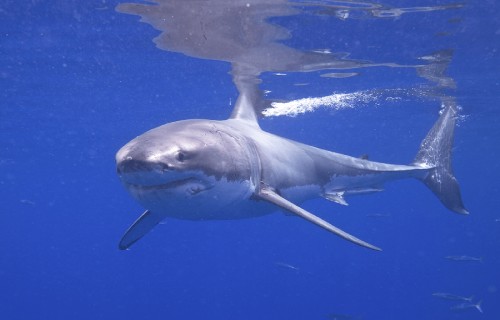
CCL: https://bit.ly/1ryPA8o
Great White Shark Distribution, Habitat, and Ecology
The astonishing Great White Shark inhabits virtually all temperate and tropical waters. It most commonly appears in coastal and offshore areas, at depths of as much as 1000 feet (300 m).
Yet, this mesmerizing hunter also often hunts at far greater depths in the open ocean.
The greatest known concentration of its numbers occurs in the waters off the coast of South Africa, in Africa.
Its lifespan averages 25-30 years. It remains famous for being a highly aggressive predator and feeding on a wide variety of prey. This includes tuna, dolphins, seals, sea turtles, sea otters, and even marine birds.
Flapjack Octopus
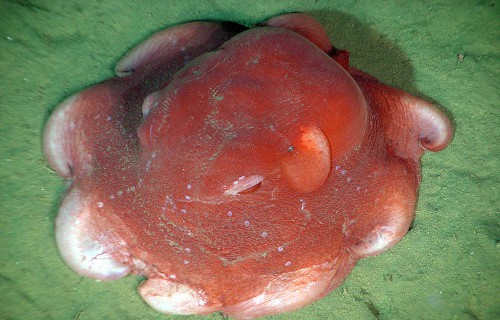
Public Domain Image
Flapjack Octopus Facts
- Here, on this list of 10 Dazzling Denizens of the Depths, comes the fabulously evolved creature named the Flapjack Octopus.
- This incredible example of the efforts of Nature and evolution most frequently goes by the common name for good reason. Sometimes, however, individuals refer to it by the alternate common name of the adorabilis, for wholly understandable reasons.
- The distinctive common names for this wonder of Nature do not simply stop there, however. That’s because the Mollusc also has yet another name used to refer to it. All members of its genus are also collectively known sometimes as flapjack devilfishes.
- Professional researchers, meanwhile, typically refer to it by its scientific name. That’s the less descriptive, and certainly less pronounceable, term of Opisthoteuthis californiana. No matter which term one uses to refer to it, it has a unique appearance.
- The first scientific notation of this cephalopod as a separate and distinct species only took place in modern times. More precisely, it occurred in 1949. This event occurred as a direct result of the efforts of the American marine zoologist, Samuel Stillman Berry.
- For the moment, little specific data concerning its population and range exists. The IUCN, therefore, now lists it as Data Deficient on the organization’s Red List of Threatened Species. This umbrella octopus seems reluctant to yield its secrets!
- The Flapjack Octopus nonetheless likely faces the same potential threats as other species around the world. These include such factors as habitat loss or degradation, and commercial fishing practices. Climate change, however, is likely its greatest threat.
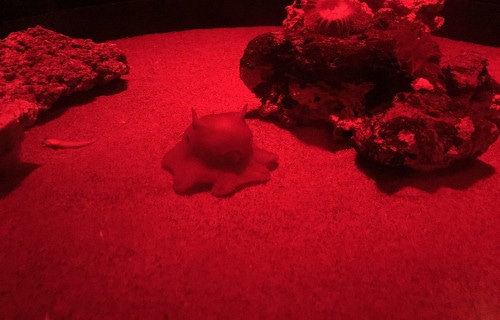
CCL: https://bit.ly/3hwZFnV
Flapjack Octopus Physical Description
The amazing Flapjack Octopus derives it most frequently used common name from its overall shape. That, as can be clearly seen here, consists of a flattened shape for the mantle. This surrounds a dome-shaped inner portion, though the body’s highly gelatinous in nature.
The cephalopod does not, however, impress one due to size, relying on its appearance for that. That holds true due to the fact that this species of umbrella octopus remains relatively tiny. In fact, individuals rarely attain a mantle length of more than 8 in (20 cm).
Unlikely many of its kindred, however, it displays no noticeable degree of the physiological characteristic of sexual dimorphism. That particular trait also distinguishes it from most known cephalopods. It’s a trait generally shared with the rest of its genus, though.
In color, the remarkable Flapjack Octopus typically appears primarily red. It does, however, often display small whitish portions along the edge of the mantle. Its eight jointed legs are fixed together, with the mantle itself strung between them, creating the umbrella appearance.
The small, but efficient eyes of this fascinating Mollusc develop affixed to the top of the bulbous head. Two small, wing-shaped structures also appear on the head, typically above the eyes. In this, the unique creature resembles some of the known varieties of squid.
- Kingdom: Animalia
- Phylum: Mollusca
- Class: Cephalopoda
- Order: Octopoda
- Family: Opisthoteuthidae
- Genus: Opisthoteuthis
- Species: O. californiana
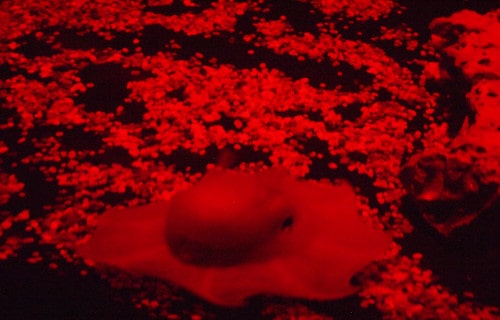
CCL: https://bit.ly/3w95fAU
Glass Octopus Distribution, Habitat, and Ecology
The remarkable Glass Octopus has a rather wide distribution across the globe. They appear to inhabit virtually all tropical and subtropical waters but remain a pelagic zone species, which contributes greatly to our lack of extensive knowledge of them. They inhabit depths ranging from 656 ft (200 m) to 13,123 ft (4,000 m), where we rarely venture.
While we know little of their reproductive processes, we do know the female broods hundreds of eggs at once. Undoubtedly carnivorous, experts assume their diet consists primarily of fish and small crustaceans sharing their zone.
Given their small size, their own natural predators likely include pelagic sharks and rays. Given the depths they inhabit, their transparent nature likely serves them well as a means of defense.
False Killer Whale

False Killer Whale Facts
- Despite their common name, as a member of the Blackfish group, the remarkable False Killer Whale isn’t a whale at all. This impressive ocean species actually represents one of the largest members of the dolphin family.
- This species exhibits the same spirit of playfulness that the smaller and better-known dolphin species do. As a result of their behavior, they remain the only member of their group to ride bow waves on a regular basis.
- However, due to their depredation of fishing lines, they continue to be routinely hunted in parts of their endemic range. Additionally, this predominantly occurs in Japan, where they, unfortunately, remain the targets of organized hunting drives.
- Due to such activities, in addition to other dangers, they now face grave concerns for their future. While the IUCN does include them on their Red List of Threatened Species, their current status remains Data Deficient.
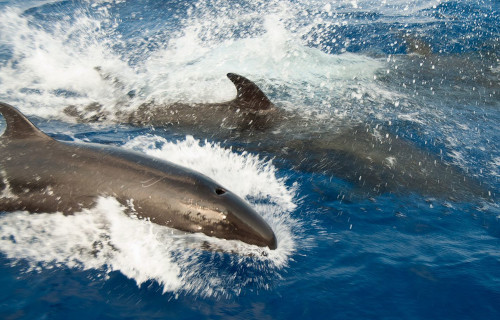
False Killer Whale Physical Description
While the False Killer Whale ranks among the largest of dolphins, individual sizes vary. This occurs partly due to the presence of sexual dimorphism between the genders. Males attain a maximum length of roughly 19.7 ft (6 m), while females only reach 14.8 ft (4.5 m).
In addition, males develop a much stockier body shape. They average a weight of 4,850 lb (2,200 kg), while females – only 2,646 lb (1,200 kg).
In general, both genders display a primarily black color, yet some individuals will be dark gray. Also, lighter patches occasionally form on the throat and chest. The head has a narrow and rather pointed shape, with a prominent bulbous melon.
While they possess no beak, the upper jaw sometimes overhangs the lower one slightly.
Kingdom: Animalia
Phylum: Chordata
Class: Mammalia
Order: Cetacea
Family: Delphinidae
Genus: Pseudorca
Species: P. crassidens
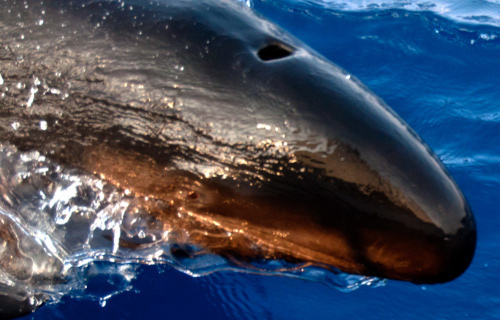
CCL: https://bit.ly/3AqKoex
False Killer Whale Distribution, Habitat and Ecology
The magnificent False Killer Whale has a broad, yet specific distribution. While they inhabit three separate oceans, they primarily occur only in the temperate or tropical regions.
They often appear on the surface, but they typically inhabit regions with a depth greater than 3,300 ft (1,000 m).
Like all dolphins, they remain carnivores and primarily feed on fish and cephalopods. Yet small marine mammals will occasionally be taken as well.
They possess a highly social nature and typically inhabit pods of between 10-60 individuals. They also often temporarily join with pods of other dolphin species, sometimes forming groups of hundreds.
This species reaches maturity at approximately 12 years of age, and have an average lifespan of about 60 years. Sadly, for reasons that remain a mystery, they also rank among the most common cetaceans to engage in mass strandings.
Narwhal
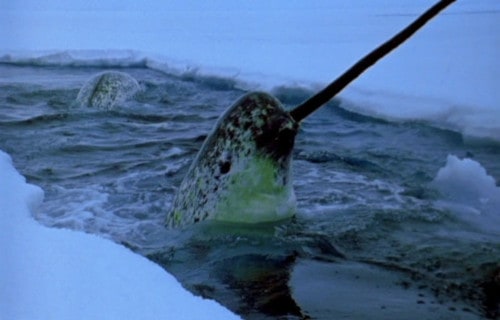
Narwhal Facts
- The rather remarkable Narwhal, Monodon monoceros, sometimes called the narwhale, ranks as a medium-sized toothed whale and the animal with the largest canines on the planet.
- The mammal grows to be a medium-sized whale, or around the same size as related species. Total length in both sexes, excluding the tusk of the male, can range from 13-18 ft. (4-5.5 m).
- Typical adult body weight measures between 1,800-3,500 lbs (800-1,600 kg).
- Males attain sexual maturity at 11 to 13 years of age, when they reach roughly 13 ft (4 m) in length, while females do so at 5 to 8 years old when they reach about 11 ft (3.3 m) long.
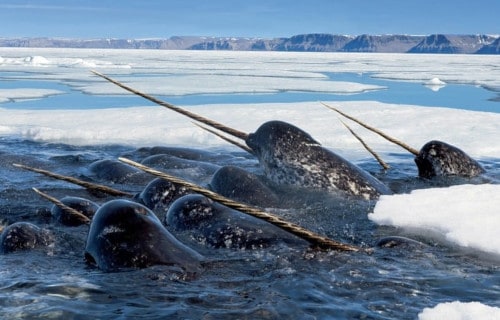
Narwhal Physical Description
The pigmentation of the Narwhal develops as a mottled pattern, with blackish-brown markings over a white background, unlike any other species of whale in any ocean.
The coloring of the creature appears darkest at birth, becoming whiter in color with age. White patches develop on the navel and genital slit at sexual maturity. Old males may be almost pure white.
Narwhals do not have a dorsal fin – possibly an evolutionary adaptation to swimming easily under ice. In addition, the neck vertebrae do not fuse together but stay jointed, like those of land mammals. Both these characteristics are shared by the beluga whale, a fellow inhabitant of icy Arctic seas.
While the tail flukes of female narwhals have front edges that sweep back, those of males have front edges that are more concave and lack a sweepback. This is an adaptation for reducing drag caused by the tusk.
Kingdom: Animalia
Phylum: Chordata
Class: Mammalia
Order: Artiodactyla
Family: Monodontidae
Genus: Monodon
Species: M/monoceros
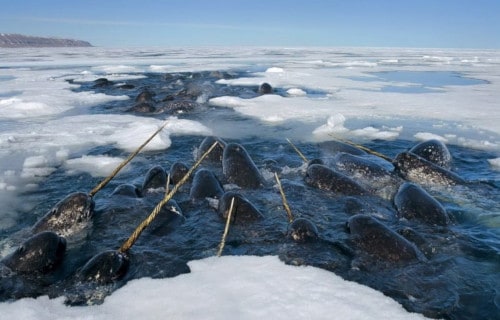
Narwhal Tusks
The most conspicuous characteristic of the male narwhal remains its single extremely long tusk. This actually represents a canine tooth that projects from the left side of the upper jaw, through the lip and forms a left-handed helix.
The tusk grows throughout life reaching lengths of as much as 10 ft (3.1 m). Despite its formidable appearance, the tusk is hollow and weighs only about 22 lbs (10 kg).
About one in 500 males has two tusks, which occurs when the right canine, normally small and less straight, also grows out through the lip.
Females may grow tusks sometimes, although the evidence on the frequency of this is somewhat conflicting. The tusks are surrounded posteriorly, ventrally, and laterally by several small teeth which vary in morphology and histology.
These teeth are vestigial and never erupt from the lip, as such the Narwhal’s mouth appears toothless.
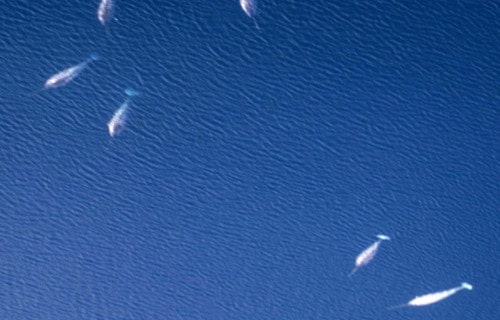
CCL: https://bit.ly/24dGLTK
Narwhal Distribution and Diet
The animal inhabits predominantly the Atlantic and Russian areas of the Arctic Ocean. Individuals also commonly appear in the northern part of Hudson Bay, Hudson Strait, and the Baffin Bay – off the east coast of Greenland.
The Narwhal often visits a strip running east from the northern end of Greenland round to eastern Russia. Additionally, the northernmost sightings of narwhal have occurred north of Franz Joseph Land.
Most of the world’s narwhals inhabit the fjords and inlets of Northern Canada and western Greenland.
They are able to survive diving to rather incredible depths of up to 4,900 ft (1,500 m) below sea level.
The Narwhal has a relatively restricted and specialized diet. Its prey predominantly includes halibut, cod, shrimp, cuttlefish, and arm hook squid. Additional items found in its stomach have included capelin, wolffish, and sometimes rocks, accidentally ingested when whales feed near the bottom.
Due to the lack of well-developed dentition in the mouth, Narwhals most likely feed by swimming towards prey until it is within close range and then sucking it with considerable force into the mouth.
Bobbit Worm
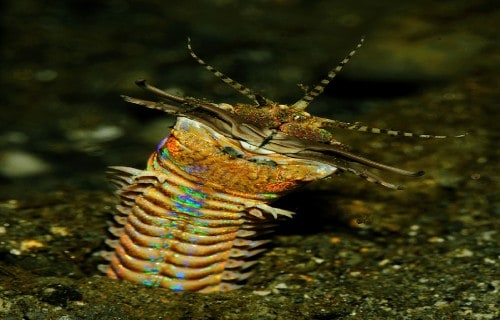
CCL: https://bit.ly/1ryPA8o
Bobbit Worm Facts
- Bobbit Worm serves as the colloquially based common name for the Eunice aphroditois.
- This worm remains also one of the most unique and disturbing predators in any ocean.
- The animal officially classifies as an aquatic predatory polychaete worm.
- It remains extremely rare to encounter and as a result, very little information is certain about the biology of the species.
- Its teeth are razor-sharp, and the creature also strikes with such speed that its prey is often cut in half.
- Its name derives from a rather notorious event that occurred in the United States, in North America, in the mid-1990’s.
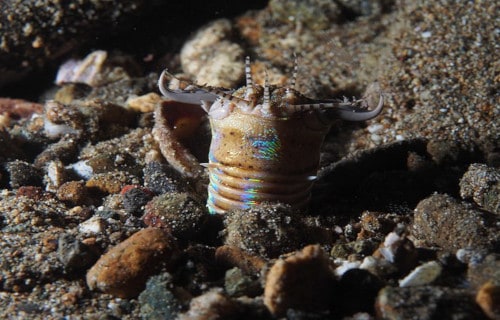
Bobbit Worm Physical Characteristics
The astonishing Bobbit Worm represents an extremely large species of aquatic worm. It typically attains an average length of roughly 39 in (1 m), but individual specimens have reached lengths of as much as 10 ft (3 m).
It also displays bright colors, most commonly including shades of bright purple. Its five antennae are useful for the detection of prey, while they remain hidden.
It is uncertain whether it possesses any toxins. Little is definite about the reproductive habits of the Bobbit Worm.
Evidence indicates that the creature likely possesses a relatively long lifespan.
Kingdom: Animalia
Phylum: Annelida
Class: Polychaeta
Order: Einicida
Family: Eunicidae
Genus: Eunice
Species: E. aphroditois
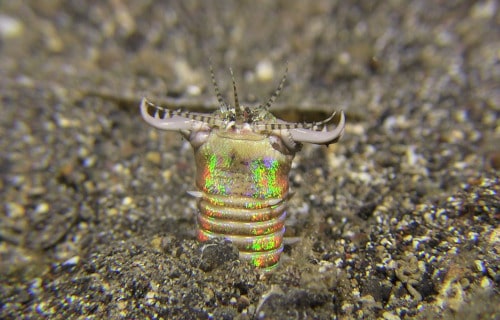
Bobbit Worm Distribution, Habitat, and Ecology
The incredible Bobbit Worm lives in most tropical waters. However, it appears to be most common in the Indo-Pacific and Atlantic Oceans.
It appears to prefer to inhabit the sand and gravel of the floor of the ocean. It will also inhabit various coral reefs. There it buries itself in the sand, with only its antennae protruding.
Though technically omnivorous, it prefers to hunt its prey as an ambush predator just like the Happy Face Spider and Spiny Bush Viper.
Once it has its prey, it typically pulls it beneath the sand or into a burrow.
Feather Starfish
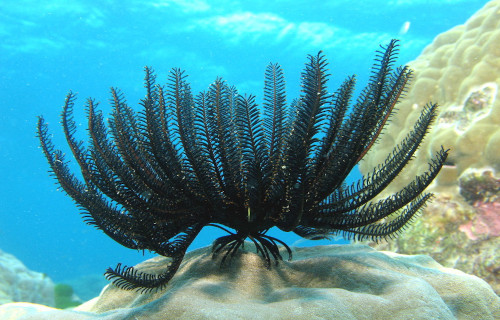
Feather Starfish Facts
- The magnificent Feather Starfish ranks as one of the most beautiful and unique species of marine animal found in any of the world’s oceans.
- Their origins date back to the Ordovician Period, which began more than 488 million years ago. Therefore, they remain one of the oldest known classes on the planet.
- Also, as an echinoderm, this creature developed a distinctly different feeding process from most other animals. The Feather Starfish and its related species possess no true stomach.
- Yet, despite the name, they do not rank as true starfish. Yet, as crinoids, marine biologists consider them to be close cousins of the starfish as they share many of the same characteristics.

Feather Starfish Physical Description
The Feather Starfish attains a rather average size of approximately 12 in (30 cm). Despite their moderate size, they display spectacular beauty. Their arms branch numerous times and result in as many as 200 branches.
By and large, the more than 600 varieties display a vivid range of colors. The mouth appears on the upper surface, and numerous feeding arms surround it. This animal has a protective internal skeleton composed of calcium carbonate, just as true starfish.
Like its starfish cousins, this species also possesses a remarkable water vascular system, instead of a bloodstream. Lastly, they breathe by absorbing oxygen directly through their tube feet.
Kingdom: Animalia
Phylum: Echinodermata
Class: Crinoidea
Order: Comatulida
Family: Antendonidoe
Genus: Florometra

Feather Starfish Distribution, Habitat, and Ecology
The most noteworthy fact about the Feather Starfish remains their wide distribution. They exist in the oceans of nearly every temperate and tropical climate. Furthermore, the various species inhabit depths ranging from the surface to approximately 30,000 ft (9,000 m).
This remarkable feeds by catching particles of food with its feeder arms and propelling it towards the mouth. They primarily feed on plankton, yet will also consume particles of detritus. While they themselves possess few natural predators, sea urchins have been known to prey upon them.
Reproduction occurs via spawning, and once hatched, the larvae mature rapidly.
Blanket Octopus
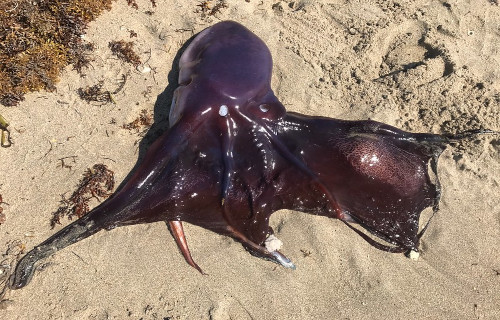
Blanket Octopus Facts
- The Blanket Octopus, or Tremoctopus, is a genus of pelagic cephalopods. The genus contains four currently known species that occupy surface to mid-waters in subtropical and tropical oceans.
- The common name of the creature is in reference to the long transparent webs that connect the dorsal and dorsolateral tentacles of the adult females.
- In fact, the other tentacles are all much shorter and lack this unique type of webbing.
- This fascinating cephalopod displays the greatest degree of sexual dimorphism among non-microscopic animals known to man.
- In fact, females may be up to as much as 10,000 times the size of the males.
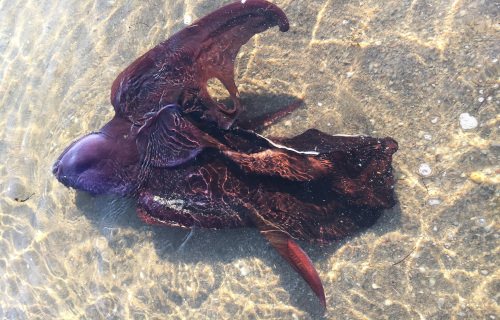
CCL: https://bit.ly/3yUjXh8
The Blanket Octopus Physical Description
Collectively, all of the known types of tremoctopus exhibit an extreme degree of sexual dimorphism. Indeed, females may reach 6.6 ft (2 m) in length, whereas the tiny males are at most a few centimeters long.
The coloring varies, of course. This genus, like most of its relatives, has the ability to change color at will. However, the most common colors display include silvery sides and dark blue or purple surfaces.
The males have a specially modified third right tentacle which stores their sperm. Further, this special tentacle is popular as a hectocotylus.
Kingdom: Animalia
Phylum: Mollusca
Class: Cephalopoda
Order: Octopoda
Family: Tremoctopodidae
Genus: Tremoctopus

CCL: https://bit.ly/3yUjXh8
The Blanket Octopus Distribution, Habitat, and Ecology
The Blanket Octopus inhabits all known tropical and sub-tropical waters of the world. It also appears to inhabit a wide range of depths, as well.
Interestingly, the Blanket Octopus is immune to the poisonous Portuguese Man O’ War, whose tentacles the male and immature females rip off and use for defensive purposes.
Like many other octopuses, the blanket octopus uses ink to intimidate potential predators. Also, when in danger, the female unfurls her large net-like membranes that spread out and billow in the water, greatly increasing her apparent size which is an evolutionary adaptation unique to this species.
The male dies shortly after mating is completed. The females carry over 100,000 tiny eggs attached to a sausage-shaped calcareous secretion held at the base of the dorsal arms and carried until hatching.
Flamboyant Cuttlefish

CCL: https://bit.ly/1eBd9Ks
Flamboyant Cuttlefish Facts
- The flesh of this astonishing creature holds within it certain acids which make the flesh of the animal inedible for humans.
- Surprisingly, the Flamboyant Cuttlefish is also actually highly toxic. This makes the species one of only three known poisonous cephalopods in all the world’s oceans. In fact, the toxicity level of its venom is equal to that of the blue-ringed octopus.
- This seemingly innocuous creature ranks as one of the deadliest inhabitants of the seas.

CCL: https://bit.ly/1ryPA8o
Flamboyant Cuttlefish Physical Characteristics
The adult Flamboyant Cuttlefish typically attains an average mantle length of roughly 3.1 in (8 cm). The arms grow wide, and quite thin, and are covered in numerous small suckers which lay in four distinct rows.
The males also possess one modified arm which they use almost exclusively for reproduction. Further, the cuttlebone of this species is smaller than in others, relative to size.
The body colors are bright and interestingly vary widely among individuals.
Kingdom: Animalia
Phylum: Mollusca
Class: Cephalopoda
Order: Sepiidae
Family: Sepiidae
Genus: Metasepia
Species: M. pfefferi

CCL: https://bit.ly/1ryPA8o
Flamboyant Cuttlefish Distribution, Habitat and Biology
The Flamboyant Cuttlefish forms a brilliantly colorful species of cuttlefish native to a particular region of the Indo-Pacific Ocean. That zone of habitation includes the waters of New Guinea, Australia, Indonesia, Malaysia, and the Philippines.
The Flamboyant Cuttlefish prefers comparatively shallow water. Also, due to the comparatively small size of its cuttlebone, it inhabits the ocean floor which makes it the only known cuttlefish species to do so. In fact, it inhabits depths ranging from between 10 – 282 ft (3 – 86 m). Further, muddy sediment and sand are its favorite regions.
The cuttlefish remains primarily active during the daytime when it hunts its prey, principally small crustaceans, and fish. Certainly, its color patterns provide excellent camouflage within its choice of habitats.
Crocodile Fish
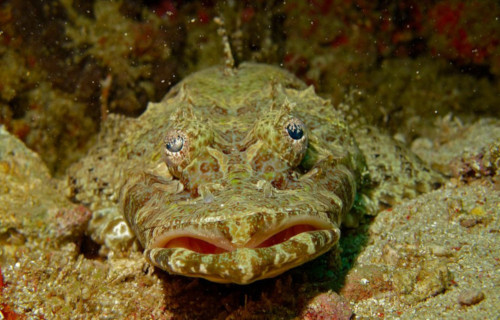
Crocodile Fish Facts
- The definitely attention-grabbing term of Crocodile Fish serves as one of the accepted common names for this remarkable marine species. It also goes by another common name, though. That alternate name’s the equally distinctive Tentacled flathead.
- Its scientific name, meanwhile, remains almost unpronounceable. That’s because it bears the tongue-twisting official designation of Papilloculiceps longiceps. By either of these terms, however, it’s undeniably a visually distinctive species.
- The French naturalist and zoologist, Georges Cuvier, made the first official recognition of the animal as a separate species. This landmark event took place in 1829. Quite surprisingly, despite his body of work, he strongly opposed the concept of evolution.
- Fortunately, the Crocodile Fish also appears to be maintaining a fairly sizeable and stable population. The fascinating creature further seems to be doing so throughout the entirety of its natural range. It’s also now spread to other areas of the globe.
- It’s believed it migrated through the man-made access provided by the Suez Canal. This, however, provided it with the opportunity to expand beyond its native range, albeit artificially. The IUCN, due to these combined factors, lists it as Least Concern.
- Although its current situation seems secure, that could change. That’s because, like most of the forms of life on earth, it now faces new threats to its continued existence. While these vary, the greatest threat no doubt comes from ongoing climate change.
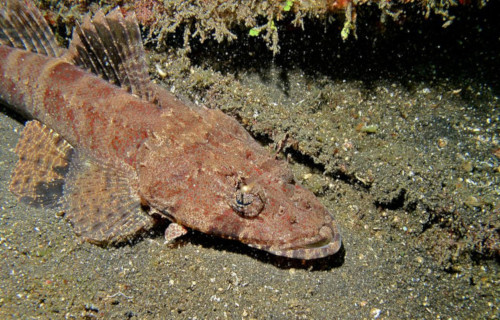
Crocodile Fish Physical Description
Although it’s true that the Crocodile Fish creates a highly imposing and intimidating appearance, it doesn’t do so due to sheer size. That’s because it actually ranks as a small variety of marine fish. Nature, it seems, places no importance on size in its various creations.
The remarkable fish further displays a moderate degree of the physiological trait of sexual dimorphism. In its particular case, this characteristic manifests itself in terms of simple size. More specifically, males of the species generally attain a greater length than females.
The difference remains relatively small, though. Overall, however, it averages roughly 19.7 in (50 – 60 cm) in total length. Exceptional specimens do occur, however. These singularly impressive individuals sometimes reach lengths of as much as 27.5 in (70 cm).
In appearance, meanwhile, individuals of both genders achieve the same general pattern. Overall, the Crocodile Fish presents a mottled combination of gray, green, and brown. This coloring, along with a knobby skin surface, gives it excellent camouflage in its habitat.
- Kingdom: Animalia
- Phylum: Chordata
- Class: Actinopterygii
- Order: Scorpaeniformes
- Family: Platycephalidae
- Genus: Papilloculiceps
- Species: P. longiceps
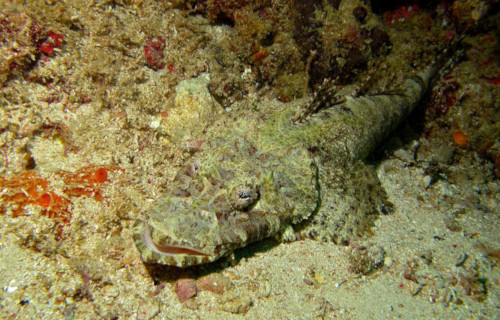
Crocodile Fish Habitat, and Ecology
Perhaps most notably, the current range of distribution of the amazing Crocodile Fish now exceeds its original one. Even now, however, its territorial range remains comparatively restricted. Its entire range still fits entirely within the Eastern Hemisphere.
More precisely, though, its native range consists solely of the Red Sea, in the Western Indian Ocean. Now, however, the actions of man have allowed it to spread to portions of the Mediterranean. For the moment, it does not appear to be expanding any further than that.
Regardless its exact location, though, the creature demonstrates a decided preference in its choice of habitat. Throughout the entirety of its range, both natural and artificial, it lives on the ocean bottom. It does nevertheless appear there only in shallow depths, near reefs.
The fascinating Crocodile Fish hunts exclusively as a predatory carnivore. On the sandy sea floor, its natural appearance allows it to lay in wait for unsuspecting prey to approach. From its concealment, it strikes, eating virtually any fish small enough to fit in its mouth.

CCL: https://bit.ly/1jxQJMa
10 Dazzling Denizens of the Depths
We certainly hope that you enjoyed reading this article on 10 Dazzling Denizens of the Depths as much as we enjoyed creating it. Our beautiful world harbors countless millions of species, many of them in our seas and oceans. They come in all shapes, sizes, and colors. Some may mesmerize you with their beauty, while others may fill you with terror.
Yet all have one thing in common. Nature evolved them to serve a purpose…to fill a niche in the ecosystems of the world. With each species that goes extinct through the actions of mankind, our ecosystems suffer a terrible loss, which Nature is hard pressed to balance. Please, join us and others in doing all that we can to preserve and protect the precious species of our world, including those that inhabit the seas and oceans.
Please check out some of our other articles on more incredible sea and ocean creatures.
Sea Swallow, Basket Star, Gulper Eel, Caribbean Reef Octopus, Tiburonia, North Pacific Giant Octopus, Bearded Fireworm









Leave a Reply